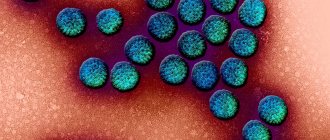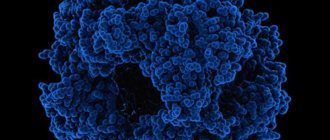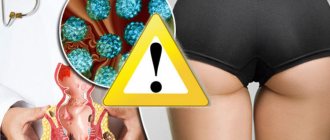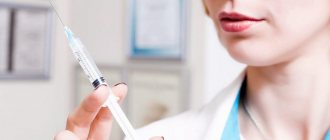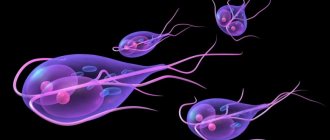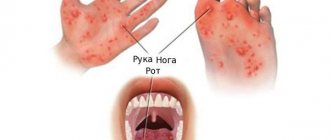Infectious disease specialist
Sinitsyn
Olga Valentinovna
33 years of experience
Highest qualification category of infectious disease doctor
Make an appointment
Rotavirus infection is a disease of viral origin that has an oral-fecal transmission mechanism. The peculiarity of the pathology is a combination of symptoms of damage to the digestive system with respiratory signs at the acute stage of the disease. The disease can be diagnosed in patients of any age, but more often in children under 2 years of age, in whom rotavirus accounts for up to 50% of all reported cases of intestinal infections.
Causes
The causative agent of rotavirus infection in children and adults is rotavirus, which has the ability to survive even when treated with potent disinfectant solutions. In the feces of a sick person, its vital activity persists for 7 months, in environmental conditions - for more than a month. The infection is transmitted from a carrier or a sick person through the fecal-oral route through water, food and household items, especially when the sanitary and hygienic condition of the premises is unsatisfactory.
Patients at risk for rotavirus include:
- childhood;
- with disturbances in the functioning of the immune system, when it is suppressed;
- with chronic intestinal diseases;
- with violations in the diet, as well as when changing baby food;
- working or visiting large groups;
- not observing the rules of personal hygiene.
Immunomodulatory and antiviral therapy
When confronted with rotavirus, the maximum level of immune defense does not develop immediately. In order for post-infectious immunity to be formed, 3 consecutive “meetings” with rotavirus are needed, and there should not be long intervals between episodes of the disease1. The fact is that rotaviruses are a heterogeneous group4, and there are different strains (subspecies) of the pathogen, which can cause repeated infections1.
Immunity plays a special role in protecting against subsequent infections with rotavirus1. Therefore, additional preventive measures should be taken in children with weakened immune systems1,5.
Anaferon® for children has antiviral and immunostimulating activity7,11. Due to the content of antibodies to human interferon gamma, the drug reduces the concentration of viruses in affected tissues, activates immune cells, and accelerates the production of antibodies7,11.
The following can be used as part of complex therapy for rotavirus infection:
- ● Anaferon® for children in the form of lozenges - for children from 6 months to 18 years7.
- ● Anaferon® children's drops for oral administration - intended for children from 1 month to 3 years11.
Anaferon® for children is one of the most studied antiviral drugs in Russia12. It has a favorable safety profile13, promotes speedy recovery and prevention12 of complications, and thanks to this has gained well-deserved recognition from specialists12.
Up to contents
Symptoms
The disease has a cyclical development: the incubation period lasts up to 5 days, the acute period lasts 7 days, recovery occurs after another 3-5 days. The main signs of rotavirus infection include:
- sudden onset of symptoms of poisoning simultaneously with symptoms of intestinal infection;
- profuse vomiting and nausea that disappear within 24 hours from the onset of the disease;
- diarrhea with pain in the middle and upper abdomen, with the release of watery and foamy stool of a yellow-green hue;
- rumbling and transfusion in the abdomen;
- signs of general intoxication - headache, fever, feeling of weakness;
- characteristic respiratory symptoms - runny nose, swelling and redness of the throat;
- signs of dehydration caused by diarrhea and excessive vomiting.
Are you experiencing symptoms of rotavirus infection?
Only a doctor can accurately diagnose the disease. Don't delay your consultation - call
Where does rotavirus live and how is it transmitted?
Every year, about 200 thousand people die from rotavirus around the world, most of them children. Half of this number is in the top five developing countries. This infection is typical for hot climates. In our country, vacationers on the Black Sea coast are at greatest risk in August. In the rest of Russia, outbreaks occur in winter and spring due to weakened immunity.
A feature of rotavirus is its extreme resistance to environmental factors. For example, it tolerates low temperatures and even repeated freezing. This is due to the presence of a protective shell on the virus itself. Therefore, it lives for a long time on the surfaces of objects and even in water. The most effective means of combating the virus in the external environment are alcohol, chlorine and boiling. It is also destroyed when exposed to acids and alkaline solutions.
Rotavirus infection occurs through the fecal-oral route. This means that the virus is excreted in feces and gets onto objects and into the mouth through poorly washed hands. Within 12 hours, the virus particles end up in the intestines, where they begin to multiply. At this moment, the first signs of the disease appear. Medicine does not give an exact answer to the question: “Is the virus transmitted by airborne droplets?”
Diagnostics
The results of the following studies help a pediatrician or therapist make an accurate diagnosis:
- a blood test showing an increase in the level of leukocytes;
- stool analysis, where there is an increase in leukocytes, starch grains, as well as undigested muscle fibers;
- serological blood test;
- positive results of infection of cell cultures with viral particles of the patient’s stool;
- PCR method that examines blood and stool samples.
Differential diagnosis is carried out to exclude a bacterial infection; the viral nature of the disease is confirmed by positive results of serological examination and bacterial culture.
Treatment
Currently, specific treatment regimens for rotavirus infection have not been developed. With a mild course of the disease, the symptoms go away on their own. Patients are advised to diet and take medications to restore fermentation in the digestive system. Enterosorbents that mitigate the symptoms of diarrhea and vomiting can help cope with the symptoms of a viral infection. If the patient is dehydrated, rehydration therapy with the use or intravenous administration of saline solutions is indicated.
Questions and answers
How is rotavirus infection transmitted?
The mechanism of transmission of the virus is fecal-oral, where the causative agent of the disease enters the environment along with the feces of the carrier or patient, and then on dirty hands into the body of a healthy person. Household items, food, dirty water - all this can become a source of infection.
What can you eat if you have rotavirus infection?
Recommendations for a patient with rotavirus infection include dietary table No. 46 with restrictions on the amount of carbohydrates and dairy dishes, as well as an increase in the amount of protein foods. This diet plan is aimed at restoring the body’s immune system and stabilizing the digestive system that has been hit by the virus.
How long does rotavirus infection last?
The duration of the disease depends on the state of health of the person and his immune system. It may take 10-15 days from the moment of infection to complete recovery, where the first 6-7 days are an acute period with a whole bunch of unpleasant symptoms. The incubation period lasts from several hours to five days, after which the infection immediately makes itself felt with a sharp deterioration in the patient’s condition.
Rotavirus intestinal infection: Symptoms and treatment in children
Rotavirus infection (rotavirus gastroenteritis or rotavirosis) is an acute intestinal infection caused by a virus of the Rotavirus genus.
The causative agent of this disease was first discovered relatively recently - in 1973. In countries where the level of medical development leaves much to be desired, rotavirus intestinal infection is one of the causes of high child mortality.
Almost all children have been infected with rotavirus at least once. It should be noted that the likelihood of re-infection is low, since after an illness a fairly strong immunity is developed. This infection is most dangerous for children aged from six months to 2-3 years.
In more than 95% of cases, sudden watery diarrhea in children is caused by rotavirus infection.
The pathogen is stable in the external environment, but quickly dies when boiled. In the human body, rotavirus dies at temperatures of 38˚ C and above.
ROUTES OF INFECTION BY ROTAVIRUS
“Intestinal flu” in children refers to the so-called “diseases of dirty hands.” The pathogen is transmitted from a sick person or a clinically healthy carrier through contact and household contact, as well as through contaminated food products (i.e., by the fecal-oral route). Even perfect adherence to hygiene rules and completely normal social and living conditions have virtually no effect on the overall level of morbidity among children.
Once in the body, rotavirus actively multiplies in the cells of the mucous membranes of the gastrointestinal tract (stomach, as well as small and large intestines). Damage to the mucous membrane is manifested by its inflammation (gastroenteritis), as a result of which the digestion process is disrupted. The pathogen is excreted in the stool, starting from the very first days after the onset of the disease.
Please note: due to its high contagiousness, rotavirus often causes outbreaks of the disease in preschool institutions.
SYMPTOMS OF ROTAVIRUS INFECTION
The duration of the incubation period can be from 1 to 5 days. Rotavirosis is characterized by an acute onset and, as a rule, a benign course. The first signs of rotavirus infection in children are:
- acute cramping pain in the abdominal area;
- vomiting (up to 3-4 times a day, including even in the morning on an empty stomach);
- decreased appetite;
- general deterioration and weakness;
- increase in general body temperature (up to 39˚ C).
Soon the patient develops acute diarrhea. Yellowish, watery stool, profuse, without blood, with a sharp sour odor. As a result of severe diarrhea, acute dehydration (dehydration) of the body develops, which can pose a threat to the patient’s life.
Signs of critical dehydration due to rotavirus infection include confusion or loss of consciousness, as well as seizures.
Other clinical manifestations that may be identified during examination include:
- redness of the ocular conjunctiva;
- hyperemia of the palatine arches and pharynx.
On the second day, as a rule, drowsiness occurs due to a general weakening of the body.
Clinical symptoms are observed for 4-7 days, after which the bright signs of rotavirus infection subside, and complete recovery occurs with the formation of a fairly stable immunity to the virus.
Mild symptoms (one-time diarrhea, slight and short-term increase in temperature) are typical for adult patients. In this case, rotavirus does not pose a particular threat, but a person, even with minor clinical manifestations, is a dangerous virus carrier for others.
TREATMENT OF ROTAVIRUS INFECTION
When the first symptoms appear, call a doctor immediately. Self-medication is dangerous.
There are no antiviral drugs that selectively act on the pathogen.
Symptomatic treatment is indicated for patients with rotavirus gastroenteritis. First of all, they need rehydration - the elimination of dehydration that develops as a result of diarrhea and vomiting. To combat dehydration and to normalize the water-electrolyte balance, it is recommended to prepare a solution of the drug Regidron for the child. The contents of 1 sachet are diluted in 1 liter of water. The baby needs to give this solution 50 ml at intervals of 1 hour. You should not drink the drug in large quantities, as vomiting may develop, and the effect will be completely opposite.
Please note: if you don’t have ready-made medications on hand, you can prepare a rehydration solution yourself. For a liter of boiled water, you need to take 1 teaspoon of baking soda (sodium bicarbonate) and table salt (sodium chloride), as well as 2-4 tablespoons of sugar. The liquid should be given to the child until normal diuresis is restored (at least once every 3 hours).
Children with rotavirus infection benefit from a gentle diet. When the first symptoms appear, milk and dairy products should be excluded from the diet, since the body does not digest lactose well due to rotavirosis. Of course, this recommendation does not apply to infants. For 2-3 weeks, it is recommended to give the baby breastfeeding 1-2 times a day, and for the rest of the feedings - soy or lactose-free formula.
A child in the acute phase, as a rule, has a complete lack of appetite, and you should not try to feed him against his will. In the first days of the disease, liquid porridge (only with water), medium-rich chicken broth and homemade jelly are recommended.
If the diagnosis of rotavirosis is confirmed, then to relieve cramping abdominal pain, the child should be given the antispasmodic drotaverine orally.
For hyperthermia, a child over one and a half years old is prescribed Paracetamol tablets. To bring down the temperature, you can also use rectal suppositories (suppositories) Cefekon. If necessary, they are placed at intervals of 2 hours.
Please note : because the pathogen dies at t = 38˚С, then it is advisable to reduce the child’s temperature only if it has risen to 39˚С or higher.
To combat intestinal upset when treating rotavirus infection, it is recommended to use Creon or Smecta.
Inflammation of the intestinal mucosa and severe diarrhea inevitably lead to dysbiosis, which negatively affects the processes of digestion and absorption of nutrients. To restore normal microbiocenosis, probiotics (bioflor, enterogermine) are indicated. It is given to children 1 capsule 2 times a day an hour before meals, dissolving the probiotic in water.
Against the background of rotavirus gastroenteritis, a secondary bacterial infection can develop.
If the child is constantly sleepy (and this is very typical for rotavirosis from the 2nd day from the onset of the disease), let him sleep as much as he needs. At the same time, do not forget to regularly measure your temperature and drink frequently, but in small volumes.
ROTAVIRUS INFECTION IN INFANTS
In infants, dehydration develops rapidly. The smaller the baby's weight, the higher the danger. Dehydration can lead to loss of consciousness and even death.
Criteria for dangerous dehydration in infants are:
- lack of sweat;
- impaired diuresis (no urination for 3 hours);
- dry tongue;
- crying without tears.
Important: remember that a sick baby may refuse a bottle of water, so this method of replenishing the lack of fluid in the body is ineffective. An infant should immediately call an ambulance! Doctors will immediately begin intravenous rehydration and, if necessary, transport the baby and mother to the hospital.
To prevent infection of other people and the subsequent spread of rotavirus infection, the patient must be isolated until convalescence (clinical recovery) occurs. All those caring for a sick child need to adhere to basic rules of personal hygiene, i.e. wash their hands with hot water and soap as often as possible.
TESTS FOR ROTAVIRUS
A stool test for rotavirus is taken (performed for a fee at the Stolbtsovsk Central District Hospital). To identify it, an antigen test is performed.
The diagnosis of rotavirus infection is considered confirmed if the pathogen is detected in the patient’s stool.
Important: the material for analysis must be delivered to the laboratory within 24 hours after receipt.
Based on the test results, a conclusion is given about the presence or absence of antigen to rotavirus in the patient’s stool. Normally, the result should only be negative.
